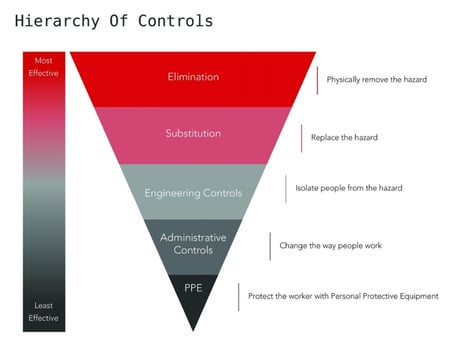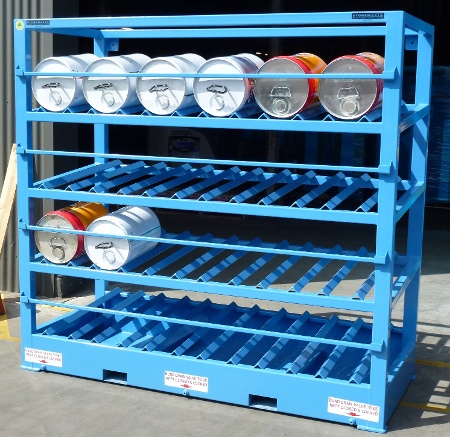If your organisation is carrying even small volumes of hazardous chemicals, you have a legal obligation to prevent and manage spillage. As you’re most likely aware, even a few drops of a corrosive, flammable or toxic substance can pose substantial risk to people, property and the environment. So, when you’re regularly working with hazardous chemicals in an organisation, how can you reduce the likelihood and impact of a spill? In this blog, we’ll be highlighting some key considerations for the prevention and management of hazardous chemical spills. Apply these considerations to your own organisation when you’re conducting your own onsite chemical risk assessment.
Eliminate or Substitute Hazardous Chemicals
In an ideal situation, you’d much rather prevent a chemical spill from occurring than have to manage a hazardous leak or spill. Referring to the Hierarchy of Controls is an important step for businesses that carry any type (or quantity) of hazardous chemicals.
By following the 5 steps outlined in the Hierarchy of Controls, you can reduce the likelihood of a chemical spill occurring in your workplace.
Consider the following points and see if they can be applied to your own site:
- Elimination - can you eliminate hazardous chemicals from your operations altogether? could you remove Class 3 Flammable Liquids in your workplace by opting for battery-powered equipment instead of petrol or diesel reliant machinery?
- Substitution - could you substitute your hazardous chemicals with a less harmful option? Ie. is there another chemical on the market which does not pose the same risks (ignition, hazardous vapours) as your existing flammable chemicals?
If neither elimination nor substitution is possible for your business, then the next step in the Hierarchy of Controls is to implement engineering controls which will isolate people from the chemical hazard.

The first step in chemical risk reduction is to consider if you can eliminate the chemical hazard from your workplace entirely.
Engineering Controls to Reduce Spillage Risk
How can you reduce the impact of a chemical spill in your organisation? There are a variety of ways in which you can implement and maintain engineering controls that can assist in the containment and management of your leaks and spills.
From selecting liquid-tight spill containment for your storage areas to reducing the amount of chemical stock that you have onsite, there are a multitude of measures that you can take to reduce spillage risk.
Bunded Transfer Equipment
From the time your chemicals are delivered to your loading dock to the moment the empty containers are discarded as chemical waste, there are countless ways in which your hazardous chemicals could leak or spill.
When transferring chemicals throughout your organisation, great care and consideration must be taken. Choosing bunded transfer equipment, such as drum dollies and bunded trollies, allows staff to reduce the physical labour associated with the transfer task as well as minimising the chance of spillage.
Likewise, if your staff are pumping or decanting chemicals, engineering controls should be in place to reduce the risk of a leak or spill. Pumping and decanting tasks can quickly turn into chemical hazards if the dispensing equipment is not in good condition, poorly fitted or simply not fit-for-purpose.

Decanting hazardous liquids without engineering controls, such as this bunded decanting rack, can result in uncontrolled spills and leaks.
Imagine a staff member decanting toxic liquids from an outdoor IBC. Using an ill-fitting hose and funnel, the staff member spills the liquid all over the work area floor, as well as over their hands and clothing. A chemical spill such as this can immediately cause serious workplace hazards such as human harm, asphyxiation and environmental contamination.
The solution here is to choose the right type of decanting equipment, so that spillage does not occur. IBCs can also be fitted with dispensing trays that will help to contain minor leaks or spills, should they occur. If you’re decanting chemicals from a drum, you can also choose drum decanting assistors, decanting racks, or poly drum rack & stacks to minimise spills during dispensing tasks.
Storage With Spill Containment
Your storage areas are most likely home to large quantities of flammable liquid, corrosive substances, organic peroxides or toxic substances. Even if you have just a few containers of paint thinners in a workshop, you should always choose bunded storage for your hazardous chemicals.
Bunded storage, such as a compliant safety cabinet or outdoor chemical storage container, allows businesses to store their dangerous goods in a dedicated area that is equipped with a liquid-tight spill containment system.
The chemical cabinet or store will be specifically designed to contain leaks and spills that may occur when the chemicals are being taken or returned to storage. Any spillage that may occur when the cabinet doors are closed will be directed into the spill sump.
Additional Safety Measures
In addition to these engineering controls, organisations can also reduce spillage risk by creating procedures, training programs and an inspection schedule to monitor the safety of their dangerous goods storage equipment.
We suggest the following additional measures for your handling and storage areas:
- Control your chemical inventory – the more dangerous goods that you have onsite, the higher the likelihood of spillage occurring. When looking at ways to reduce risk, start with a chemical management program. If you can keep your hazardous chemical stocks at a reasonable level, you will avoid stockpiling chemicals, thereby minimising the impact of a spill.
- Create strict handling and storage procedures – your staff are the first line of defense against chemical hazards in your workplace. If your business arms staff with the knowledge and training required for the correct handling and storage of your chemicals, you will reduce the risk of spillage, as well as other chemical hazards.
- Compliant stacking and loading – there are many factors to consider when using a safety cabinet or outdoor store. These include not overloading the cabinet and practicing the correct stacking and loading procedures. By ensuring that your cabinets are being used in the right way, you are reducing the risk of containers becoming unsteady or falling over while they’re in storage.
- Keep containers on whenever the chemical’s not in use – the simplest thing that your staff can do to reduce the likelihood and impact of a spill is to keep chemical containers secured when they’re not being used. Make sure that all chemicals are stored in a compliant container, with a lid firmly secured when the substance is not in use.
- Regular inspections and housekeeping – your engineering controls are only as good as the systems in place to keep them compliant. By implementing regular inspections and housekeeping for your controls, you can ensure that they are free of leaks, spills and hazardous residue.
Creating a Compliant Spill Response
While we’ve listed many things that you can do to reduce the risk of spillage, you must still be prepared to act quickly and decisively if a leak or spill does occur in your business.
If your organisation carries any quantity of hazardous chemicals, you should have a Spill Response Plan in place. This plan will detail how to manage a chemical spill, as well as your emergency evacuation procedures if the spill is beyond your clean-up capabilities.
An integral tool in the spill response is the provision for chemical spill kits. These kits will be tailored to suit the type and quantity of hazardous chemical that you’re carrying. They should also be placed close to any handling or storage area that may be prone to a leak or spill
Chemical spill kits may include oil and fuel spill clean-up kits (hydrocarbon spill kit), universal spill kit (suitable for many types of chemical spills), chemical spill kits (for aggressive chemicals) or marine spill kits (for spills that occur at sea).
![]() Choose the spill kits that suit the type and quantity of chemicals that your business is carrying.
Choose the spill kits that suit the type and quantity of chemicals that your business is carrying.
Your kit must be treated in the same way that you’d treat other controls in your business. This means that you must always ensure that:
- The kit is compliant and suitable for use with your chemical class
- It contains clear, easy-to-understand instructions
- Staff are trained to use the kit and action the Spill Response Plan
- The spill kit is regularly inspected
- Any missing or damaged items are immediately replaced
Procedures must also be in place to deal with the chemical waste and resulting effluent that is caused by the spillage. Spills will result in a range of waste products including empty chemical containers, contaminated materials, water or soil, and soiled absorbents and booms. Your waste management plan should comply with your state or territory’s regulatory authority, without further hazards during the waste disposal process.
Reducing Leaks and Spills in the Workplace
As we’ve discussed in this blog, you can reduce the impact of a hazardous chemical spill by implementing spillage prevention and management controls. These will include engineering controls, such as bunded flammable cabinets, as well as the creation of handling and storage procedures, the training of staff, and the placement of compliant spill kits.
To help you learn more about preventing chemical spills (and other hazards) in your organisation, we’re created an easy-to-read eBook. How To Manage The Risk Of Hazardous Chemicals In The Workplace will help you minimise hazards by ensuring your workplace is 100% compliant. Access your copy for free today and reduce spillage in your workplace.
Joining the team as a Dangerous Goods Storage Consultant, Melissa Hampton became Storemasta's Marketing Manager in late 2021. With extensive knowledge and experience in chemical compliance, Melissa is responsible for leading the Marketing team and helping shape their marketing strategy. In her spare time, you can find Melissa hiking, swimming and enjoying the great outdoors in beautiful north-west Tasmania.

